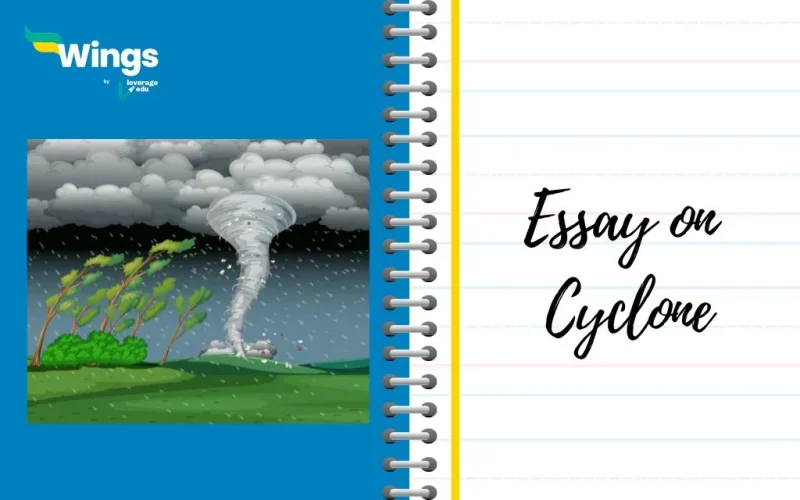Essay on Cyclone: A cyclone is a powerful storm with strong winds and heavy rain that can cause great destruction. It forms over warm ocean waters and moves toward land, bringing floods, high-speed winds, and damage to buildings, trees, and roads. Cyclones can lead to loss of life and property, making them one of the most dangerous natural disasters. However, with early warnings and safety measures, people can reduce their impact. In this essay, we will discuss how cyclones form, their effects, and ways to stay safe during a cyclone.
Contents
Essay on Cyclone in 150 Words
A cyclone is a violent storm with strong winds and heavy rainfall, mostly occurring in coastal areas. It forms over warm ocean waters when moist air rises and creates a low-pressure system. As it moves toward land, it brings destruction, including floods, property damage, and loss of life.
India often faces cyclones, especially in states like Odisha, West Bengal, and Andhra Pradesh. The 1999 Odisha Super Cyclone was one of the deadliest, killing nearly 10,000 people. Another severe cyclone, Amphan (2020), caused massive destruction in India and Bangladesh.
Cyclones are classified into categories based on wind speed. A severe cyclone can reach speeds of over 200 km/h, uprooting trees, damaging homes, and causing large-scale displacement. Governments issue early warnings and evacuate people to minimise loss. The Indian Meteorological Department (IMD) plays a crucial role in tracking cyclones.
To stay safe, people should move to cyclone shelters, store emergency supplies, and avoid going outside during the storm. Though cyclones are dangerous, preparedness can help reduce their impact and save lives.
Must Check Out:
Essay on Cyclone in 250 Words
Cyclones are massive storms that develop over warm ocean waters. They occur when the sun heats the sea, causing water to evaporate. As the warm air rises, it creates a low-pressure system, pulling in more air. When strong winds start rotating around this system, a cyclone is formed.
Cyclones are known by different names in different regions—hurricanes in the Atlantic, typhoons in the Pacific, and cyclones in the Indian Ocean. In India, the east coast experiences more cyclones due to its long coastline and warm waters. Cyclones bring heavy rainfall, strong winds, and storm surges that flood coastal areas.
The effects of cyclones can be devastating. In 2013, Cyclone Phailin caused large-scale destruction in Odisha, damaging over 500,000 houses. Similarly, Cyclone Tauktae (2021) affected western India, killing several people and disrupting normal life. Apart from property loss, cyclones destroy crops, leading to food shortages and economic losses.
To prevent severe damage, early warnings and evacuations are crucial. Governments use satellite technology to predict cyclones and alert people in advance. Stronger infrastructure, like cyclone-resistant buildings and well-equipped shelters, can reduce losses. Planting more trees also helps as they act as windbreakers.
Understanding cyclones and preparing for them can save lives and protect communities from destruction.
Also Read: Types of Cyclones
Essay on Cyclone in 350 Words
A cyclone is a powerful storm that forms over tropical oceans. It is caused by the combination of warm sea temperatures, moist air, and the Earth’s rotation. When warm air rises from the ocean, it creates a low-pressure area, pulling in surrounding air. This air spins due to the Earth’s rotation, forming a swirling system.
Cyclones are classified into five categories based on their wind speed. A Category 1 cyclone has winds of 74-95 mph, while a Category 5 cyclone can have winds above 157 mph, causing catastrophic damage. The centre of the cyclone, known as the eye, is calm, but the surrounding area, called the eye wall, has the most intense winds and rainfall.
Cyclones have severe effects on both human life and nature. They cause floods, landslides, and destruction of property. For example, Cyclone Yaas (2021) hit India’s eastern coast, causing damages worth INR 15,000 crores. Coastal villages were submerged, and thousands of people were displaced. Additionally, cyclones disrupt power supplies, transportation, and communication networks.
To stay safe during a cyclone, people should follow official warnings and move to safe shelters. Keeping emergency supplies like food, water, and medicines is essential. Authorities build cyclone shelters in vulnerable areas to provide safety. Countries also use weather satellites and radars to track cyclones and give early warnings.
Climate change is increasing the frequency of cyclones due to rising sea temperatures. It is important to take preventive measures such as planting mangroves along coastlines to reduce storm impact. Stronger infrastructure and better disaster management strategies can help protect lives and property.
Though cyclones are natural disasters, preparedness and scientific advancements can help minimize their damage and save many lives.
Also Read: Essay on Disaster Management
10 Important Lines on Cyclone
Here are 10 important lines for an essay on cyclone:
- A cyclone is a powerful storm with strong winds and heavy rainfall.
- It forms over warm ocean waters due to low-pressure systems.
- Cyclones bring floods, high waves, and destruction to coastal areas.
- In different parts of the world, they are called hurricanes or typhoons.
- India’s coastal states like Odisha and West Bengal often face cyclones.
- Cyclone Amphan (2020) and Cyclone Tauktae (2021) caused severe damage in India.
- Cyclones are categorised based on wind speed, with severe ones exceeding 200 km/h.
- The Indian Meteorological Department (IMD) gives early warnings to help people stay safe.
- People should move to cyclone shelters and store emergency supplies during a cyclone.
- Preparedness, strong buildings, and tree plantation can help reduce cyclone damage.
Also Read: Global Warming Essay
FAQs
A cyclone is a large, powerful storm characterised by strong winds and heavy rain. It forms over warm ocean waters and can cause significant damage when it reaches land.
Cyclones develop when warm, moist air over the ocean rises, creating a low-pressure area. As this air rises and cools, it forms clouds and releases heat, which fuels the storm. The Earth’s rotation causes the storm system to spin, leading to the formation of a cyclone.
There are two main types of cyclones:
Tropical Cyclones: These form over warm tropical oceans and include hurricanes and typhoons.
Temperate Cyclones: Also known as extratropical cyclones, these occur in higher latitudes and are associated with cold and warm fronts.
Cyclones can lead to:
Strong winds that damage buildings and infrastructure.
Heavy rainfall causing flooding.
Storm surges leading to coastal flooding.
Disruption of power and communication lines.
Cyclones are named to help identify and communicate about them clearly. Different regions have their own naming systems. For example, in the Indian Ocean region, countries submit lists of names, which are used sequentially when new cyclones form.
Preparation includes:
Staying informed through weather updates.
Having an emergency kit with essentials like water, food, and medications.
Securing your home by reinforcing windows and doors.
Knowing the nearest evacuation routes and shelters.
The ‘eye’ is the calm centre of a cyclone. While the eye itself is relatively peaceful, it is surrounded by the ‘eye wall,’ which contains the most severe weather conditions, including the strongest winds and heaviest rains.
Some studies suggest that while the total number of cyclones may not be increasing significantly, the intensity of cyclones is rising. Warmer ocean temperatures can lead to more powerful storms, resulting in greater damage when they make landfall.
Popular Essay Topics
For more information on such interesting topics, visit our essay writing page and follow Leverage Edu.
 One app for all your study abroad needs
One app for all your study abroad needs














